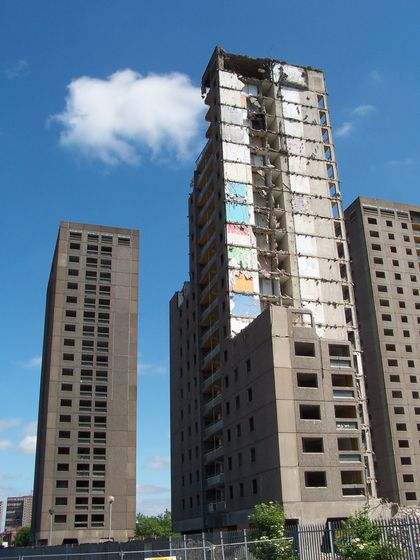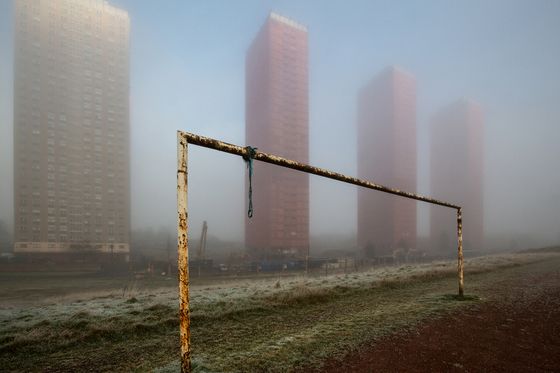Why did the city “Glasgow”, where the inhabitants die abnormally prematurely, be born?

Urban living makes us miserable. This city is trying to change that | Mosaic
https://mosaicscience.com/story/urban-living-city-mental-health-glasgow-cities-happiness-regeneration/
Glasgow men are seven years shorter than men in other British cities, and one in four people are said to be unable to reach their 65th birthday. Various causes have been debated about the cause, and various theories have been proposed, such as the weather, vitamin D deficiency, and eventually “overeating fried Mars bar ”.

by
So David Walsh, manager of public health programs at the Glasgow Public Health Center, created a report that examined a total of 40 hypotheses and pursued the health issues of Glasgow. As a result, it turned out that it was “the highest cause of poverty”. “We are in an economic situation where one in three children in Glasgow is classified as poor,” Walsh points out.
But mere poverty alone does not explain Glasgow's high mortality. So journalist Fleur McDonald, who contributed articles to Mosaic, decided to look at Glasgow's modern history.
◆ Cause 1: Rapid demographic change
Since the industrial revolution, the population of Glasgow, which flourished in industry and shipbuilding, has grown explosively. In 1951, 1,779,000 people lived, nearly twice the population of 580,000 in 2006. Faced with overpopulation, Glasgow considered two approaches. The first is “building high-rise housing around the city centre” and the second is “moving workers to the suburbs”. The conclusion that the Glasgow Parliament at that time made was “both implemented”.
However, rapid changes in demographics soon surfaced as disastrous consequences. First, by moving workers to residential areas outside the city, the number of households with a stable income from Glasgow drastically decreased. In addition, the security was worsened by the poor being pushed into the housing complex built in the center of the city. 'Tajiru soup'.
Anna, who lived with her daughter in the tower block of an apartment house built in Glasgow at the time, told McDonald's interview, “My daughter has been threatened with a bread knife. I couldn't have one child on the Tower Block, ”he recalled.

by
After that, Tower Block became a burial place for crimes such as robbery, assault, and drug trafficking, and many residents including Anna and others moved. The resulting vacancies were devoted to further housing the poor, and friction within the local community was intensified. Eventually, tower blocks were demolished one after another in the 2000s.
◆ Cause 2: Drinking culture
The man in Glasgow at the time, an industrial city, decided to hang out at the pub instead of going home after work, and there was no public meeting place other than a bar. Carol Craig, a writer who has written a book on Glasgow during the Industrial Revolution, says, “In families with habitual drinkers, there is a tendency for domestic violence and child sexual abuse.” Says.
Craig pointed out, “Children raised in stressful families such as domestic violence, abuse of neglect , and parental alcoholism often have mental and physical problems when they grow up.” As a result, he says that he suffers from mental disorders and addictions and makes his child experience the same.
◆ Cause 3: Overpopulation
Many households lived on the tower block, and not only the entrances and exits of the hallways and buildings, but also toilets and bathrooms were often shared. Psychologist Andrew Baum conducted an experiment on the impact of this living environment on human health.
The experiment was to observe students who lived in 'dormitories where almost everyone shares a lounge and bathroom' and 'student dormitories shared by groups of 4 to 6 people' among the student dormitories at State University of New York at Stony Brook To do. As a result of this experiment, the students in the dormitory where all students share bathrooms, etc., tend to have more stress and poor grades than the other, and have a lot of antisocial behavior.
In addition, architect Oscar Newman said about the result of a visit to Pluit Igo , which is considered to be the failure of the worst housing plan in American history: `` House shared by only two households was well managed, but 20 households The shared space was a disaster, ”testified. He pointed out that many people living in the same place have a serious negative impact on the safety of the living environment, as the responsibility for housing management becomes ambiguous.
◆ Cause 4: Disparity
In the co-authored “ The Inner Level ”, epidemiologists Kate Pickett and Richard Wilkinson said, “In urban areas, the poor and the wealthy live in the same area, so the residents I will witness it. ' He expressed his view that stress in the face of inequality is a stress for both the poor and the rich, and is detrimental to mental health.
A 2004 study conducted by Pace University psychologist Sally Dickerson and others found that the stress caused by social disparity had the strongest impact on stress hormone secretion compared to other types of stress doing.
Liz Zaidler, chief executive of the British charity Happy City Initiative , which aims to make policy proposals for urban planning, said, “In places where there is a great inequality, people are worried about security, It creates a mental barrier around them, ”stressing the negative effects of disparities on the community.
◆ Cause 5: Stress in urban areas
Some studies have shown that living in the city itself can cause tremendous stress. Andreas Meyer-Lindenberg, a psychiatric professor at the Mannheim School of Medicine at the University of Heidelberg, conducted an experiment to solve mathematical problems while monitoring brain activity for a total of 55 students. Also, during the experiment, students were wearing headphones with negative words to reproduce social stress.
As a result, the students from the urban area were more responsive to the amygdala, the part of the brain that responds to stress than the students from the rural area.
Mayer-Lindenberg, who has been involved in schizophrenia research for many years, said McDonald ’s telephone coverage: “Urban life has an overall negative impact on mental health. There are few positive aspects. '.

On the other hand, according to Meyer-Lindenberg, “From an epidemiological perspective, urban areas should have a positive effect on health, because urban life is generally rich and well-educated and well-educated. 'I pointed out,' he pointed out that some sort of problem existing in urban areas was taking away the benefits of living in urban areas.
◆ Possibility that nature is necessary
It has also been suggested that it may be “lack of experience of touching nature in childhood” that is detrimental to the health of people living in cities. Richard Mitchell, a sociologist at the University of Glasgow, investigated the stress of people living in areas that are economically poor but rich in the natural environment. As a result, contrary to the image that people living in pastoral life are spiritually rich, the stress from poverty has had a huge negative impact on people, and living in a rich natural environment contributes almost to mental health. It was not.
On the other hand, Mitchell has found that there is something in common among those who are very resistant to mental disorders, even in poverty. It is an experience that acquired the skills to touch nature such as Boy Scouts. From this result, Mr. Mitchell says, “It is thought that the experience of actively interacting with nature in childhood gives very strong resistance to mental health after adulthood” .
Similar conclusions have been drawn from research by researchers other than Mitchell.
Children raised in places with little green have a 55% higher risk of mental illness-GIGAZINE

by Leo Rivas
Some people have felt the importance of nature based on experience rather than academic research. There was once an undeveloped green space near Emily Katz's house in western Glasgow. This green space was used as a soccer field by local children, but the goal post was removed because of the redevelopment plan and land acquisition. As a result, the green space has become a hangout for drug addicts.
Therefore, Katz developed a petition activity for several years to protect the green space, and appealed to the need for the green space when he went to local gatherings and events. Katz's efforts worked, and the Scottish government withdrew its green space redevelopment plan in 2016. As of 2019, it is said to be a park called “Children's Wood”.
Katz said, “Green land is definitely indispensable to the local community. However, there are not many cases like children's wood in other places,” children living in urban areas say. Appealed for the need to provide a place of contact with nature.
Related Posts:
in Note, Posted by log1l_ks






